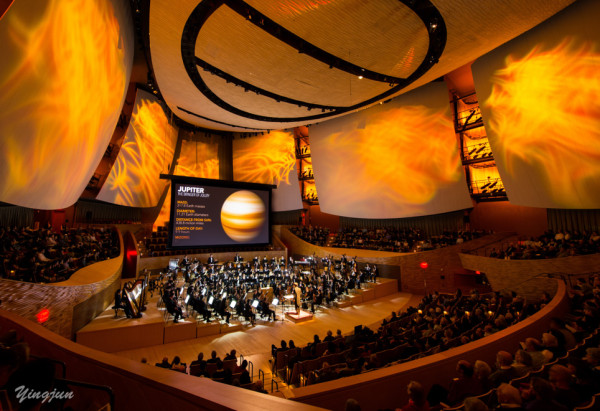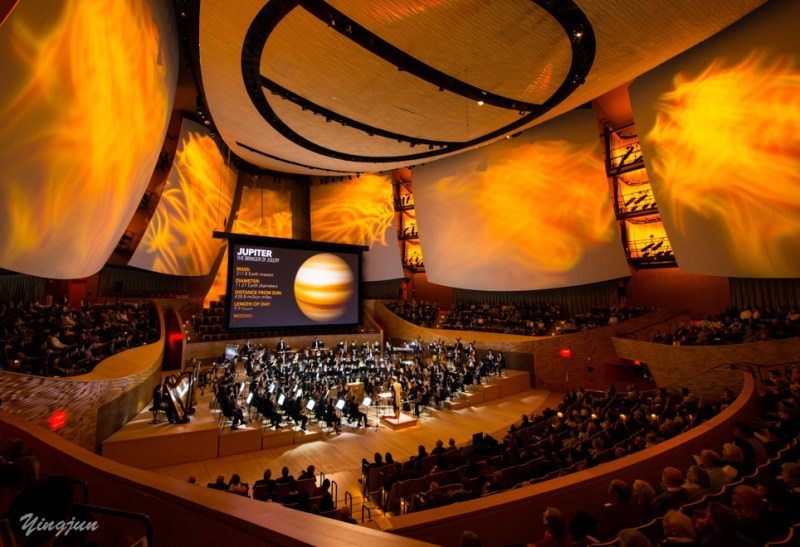
Cosmic activity prevailed at Bing Concert Hall last weekend. The Center for Computer Research for Music and Acoustics (CCRMA) and the Stanford Symphony Orchestra (SSO), led by conductor Jindong Cai, presented a stellar program featuring new and old classical music enhanced by vibrant visualizations of our universe.
The first half of the program involved a premiere of New York-based experimental composer Sarah Weaver’s Universal Synchrony Music, Volume 3, which was completed in collaboration with the NASA Kepler Mission and NASA ArtSpace. In her work, Weaver explored the synchrony of our universe by “translating” information from data streams about the alignment of planetary orbits and constellations into music and sound. CCRMA teamed up with the Ensemble at York University in Toronto, Canada, through bidirectional live transmittance of sounds to create an evocative musical experience.
Tension was instantly palpable from the opening bars. A soft hissing emanated from the speakers, which was then overlaid with disparate, ringing tones varying in pitch, texture, length and dynamic — from insistent honks, to warning beeps, to even the chime of a striking clock, all of which mingled with the smooth ringing notes performed live by percussionist Dylan D. Hunn and pianist Zhengshan Shi. Although a sense of quiet stillness pervaded the performance — when not playing, Hunn and Shi remained motionless as if absorbed in a hypnotic abstraction — a low, constant drone throughout the piece warded off the looming weight of silence.
Nonetheless, the piece felt empty and tense, like the void of a black hole. Whispering tones streaming from an unseen source made it seem like something in the unknown was stirring in the darkness. The two performers, as if aware of this sinister presence, played with measured care, as if even a modicum of excessive force would disrupt the delicate equilibrium.
The visuals, interestingly, did not appear to share their restraint. Two HD screens behind the performers displayed bursts of colorful abstractions; lines, streaks and swirls flitted on and off the screens in seizures of color, spinning, diving and blinking in a collision of fantastic imagery.
Afterwards, the avant-garde gave way to the Stanford Symphony Orchestra’s passionate rendition of “The Planets,” a piece written by English composer Gustav Holst exactly 100 years ago from 1914-16. “The Planets,” a suite composed of movements representing each planet in the solar system (with the exception of Pluto), is based on Greek mythology: Holst assigned each planet a distinct personality, such as “Venus, Bringer of Peace” and “Jupiter, Bringer of Jollity.” The orchestra’s performance also made ample use of visuals, which included a series of photos and footage to display on the projector during each movement.
SSO brought impressive clarity in articulation and entrances, with Cai coaxing an exquisite balance between instrumental sections and contrasting melodic lines. From the persistent, ominous pulse of “Mars, Bringer of War” to the lumbering, ponderous chords of “Saturn, Bringer of Old Age,” the orchestra performed as a cohesive unit, pulling back and moving forward together through majestic, soaring phrases and staccato scales.
The ensemble’s brilliant technique was particularly evident in the opening of “Mercury, the Winged Messenger,” in which the players bolted rapidly through lively scales, remarkably clear and splendidly playful in this capricious movement.
For the final movement, “Neptune, the Mystic,” members of the Symphony Silicon Valley Chorale added their heavenly voices from backstage; their airy tones and the chords of the harps contributed to the diaphanous quality of the suite’s ending.
Haunting, mysterious and enlightening, CCRMA and SSO offered a glimpse into the our wonderful universe while exploring the limits of technology and how it is transforming perceptions of sound, distance and the world around us. Through this whimsical concert, we discovered that space is much more wonderful than we first thought.
Contact Marisa Lin at mlin3 ‘at’ stanford.edu.
